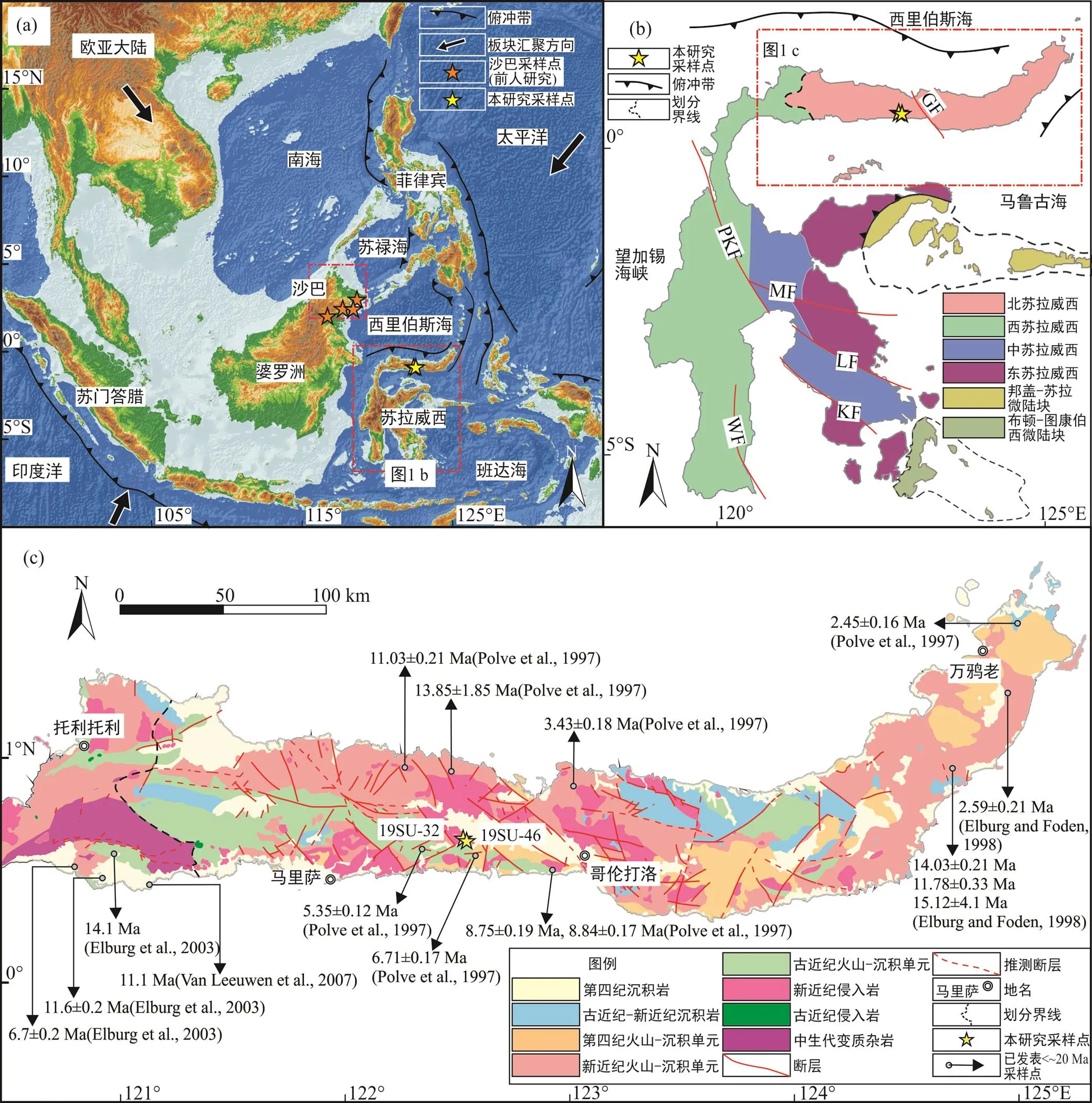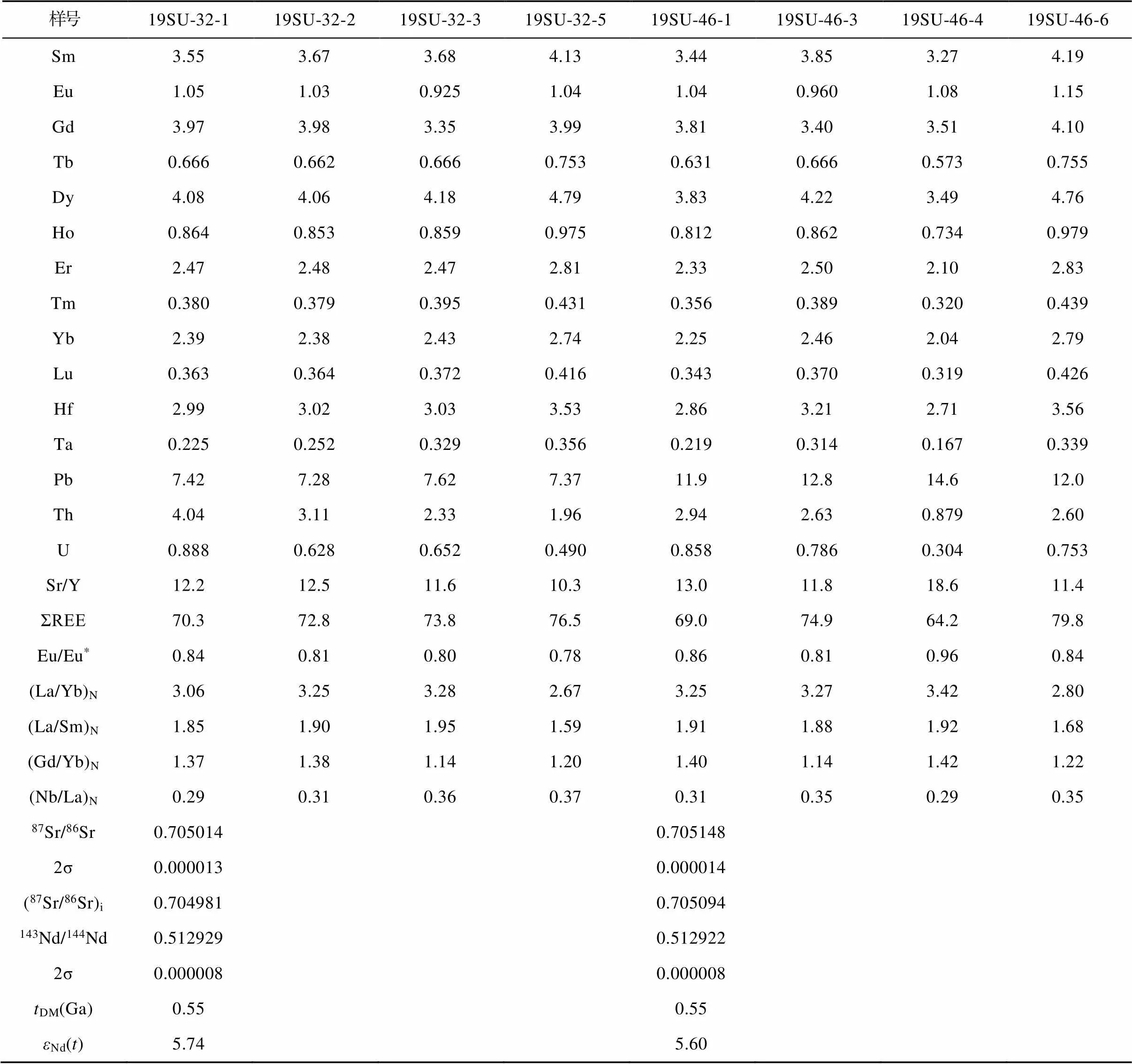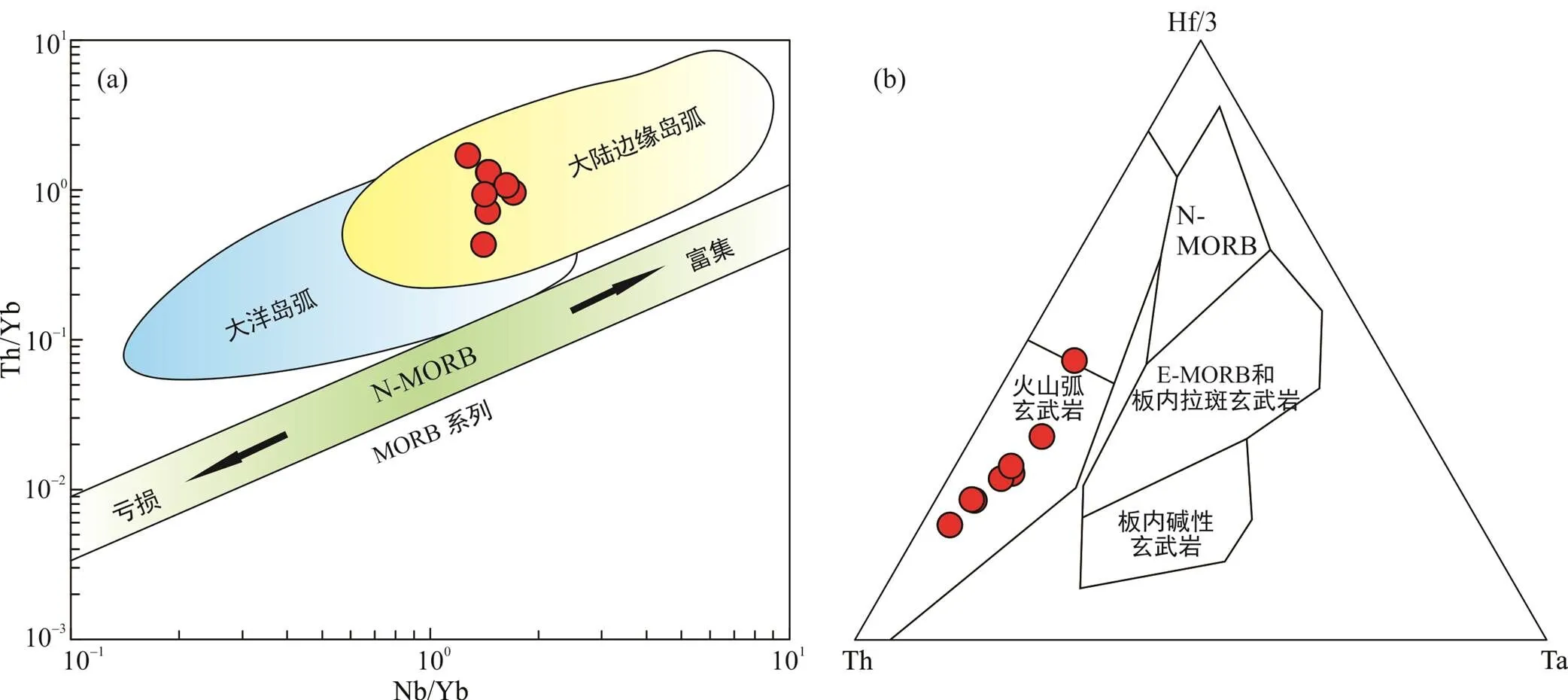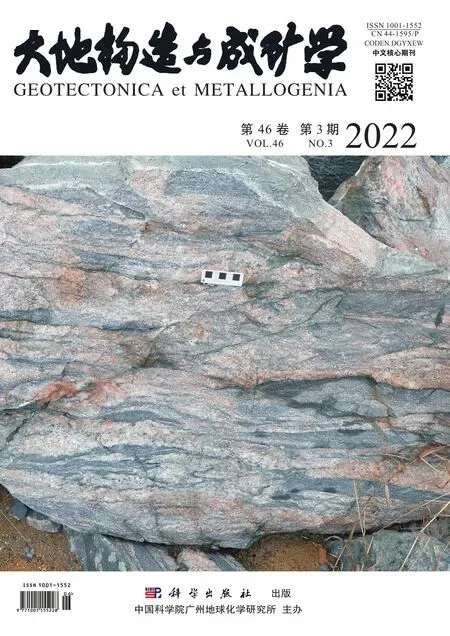印尼北苏拉威西中部~10Ma闪长岩的岩石成因及对西里伯斯海向南俯冲的启示
卢向红, 钱 鑫, 2*, 甘成势, 2, 张玉芝, 2, 吴赛男, 王岳军, 2
印尼北苏拉威西中部~10Ma闪长岩的岩石成因及对西里伯斯海向南俯冲的启示
卢向红1, 钱 鑫1, 2*, 甘成势1, 2, 张玉芝1, 2, 吴赛男1, 王岳军1, 2
(1. 中山大学 地球科学与工程学院, 广东省地球动力作用与地质灾害重点实验室, 广东 珠海 519082; 2. 南方海洋科学与工程广东省实验室(珠海), 广东 珠海 519082)
苏拉威西岛位于欧亚、太平洋和印度‒澳大利亚板块的交汇处, 经历了复杂的构造演化历史, 保存了大量中‒新生代岩浆记录。本研究对北苏拉威西中部闪长岩开展了锆石U-Pb年代学和Lu-Hf同位素、全岩元素‒同位素地球化学研究。研究显示, 闪长岩锆石U-Pb年龄为10.32±0.44 Ma和9.87±0.11 Ma, 形成于晚中新世。样品SiO2含量为53.81%~59.90%, MgO为3.27%~4.27%, K2O为0.48%~1.22%, A/CNK=0.86~0.92, Mg#为47~49, 属高镁中钾钙碱性闪长岩。该闪长岩以富集大离子亲石元素和轻稀土元素、亏损高场强元素为特征, 具明显Nb-Ta和Ti负异常, 轻微Eu负异常(Eu/Eu*=0.78~0.96)。闪长岩(87Sr/86Sr)i值变化于0.70498~0.70509之间,Nd()值变化于+5.6~+5.7之间, 锆石原位Hf()值为+11.2~+16.9。地球化学特征显示印尼北苏拉威西中部闪长岩源区受到了俯冲组分的交代改造, 可能是亏损地幔源区辉石岩的部分熔融产物。结合区域地质研究, 认为北苏拉威西晚中新世闪长岩形成于岛弧背景, 受控于晚中新世西里伯斯海的向南俯冲。
锆石U-Pb年代学; 晚中新世; 高镁闪长岩; 西里伯斯海俯冲; 北苏拉威西
0 引 言
东南亚地区分布有一系列边缘海盆地(如苏禄海、西里伯斯海、马鲁古海、班达海和爪哇海等)和岛链(如菲律宾、巴拉望、北苏拉威西和爪哇等), 它们的形成大多与新生代印度‒澳大利亚板块与欧亚板块的汇聚、太平洋板块的俯冲和南海的扩张消亡等构造过程密切相关(图1a; Hall, 2002, 2012; Advokaat et al., 2018)。苏拉威西岛呈K字型展布于印尼东部, 由多个地质单元构成(图1b; Katili, 1978; Hamilton 1979; Polvé et al., 1997; White et al., 2014, 2017)。自中生代以来, 该地区经历了陆块裂离、板片俯冲和增生碰撞等复杂演化历史, 已成为研究俯冲带岩浆作用的天然实验室(Priadi et al., 1994; Polvé et al., 1997; Hall, 2012; Hennig et al., 2016; Van Leeuwen et al., 2016; Maunala et al., 2016, 2019; Zhang et al., 2020)。
北苏拉威西主要发育有新生代岛弧岩浆岩和相应沉积作用(图1c), 该区已发表的岩浆岩年代学资料多为K-Ar年龄数据, 主要分布于22~0.9 Ma, 被认为是多期岩浆活动的产物(Kavalieris et al., 1992; Surmont et al., 1994; Polvé et al., 1997; Elburg and Foden, 1998; Hanyu et al., 2012)。但时至今日, 对北苏拉威西岩浆岩的精细年代学限定还相对薄弱, 对它们的地球化学特征及其岩石成因缺乏深入认知(图1a; Kopp et al., 1999; Hanyu et al., 2012; Leo et al., 2013)。现有资料表明, 西里伯斯海形成于始新世, 发育多期俯冲岩浆作用(Silver et al., 1983a; Hutchison, 1989), 而马鲁古海俯冲作用以发育大量晚中新世‒上新世弧岩浆岩为特征(Hanyu et al., 2012)。目前北苏拉威西地区的岩浆作用与其西北侧西里伯斯海或东南侧马鲁古海的俯冲之间存在何种关联仍不清晰。值得关注的是, 西里伯斯海海盆具与南海和苏禄海近于平行展布的磁异常条带特征(Silver et al., 1983b), 因此, 在位于南海以南、西里伯斯海南缘的北苏拉威西地区开展详细的岩浆作用研究, 可以更好地理解西里伯斯海的形成演化, 乃至了解南海的扩张与俯冲消减提供重要启示(Silver and Rangin, 1991; Spadea et al., 1996; 李家彪等, 2011; 王鹏程等, 2017)。

GF. 哥伦打洛断层; PKF. 帕鲁‒科罗断层; WF. 瓦伦奈断层; MF. 马塔诺断层; LF. 劳诺波断层; KF. 科拉卡断层。
1 地质背景及岩相学特征
苏拉威西岛发育的主要断裂包括哥伦打洛断裂、帕鲁‒科罗断裂、马塔诺断裂、劳诺波断裂、科拉卡断裂和瓦伦奈断裂等(图1b)。根据时代和演化的不同, 苏拉威西岛又分为西苏拉威西、北苏拉威西、中苏拉威西、东苏拉威西、邦盖‒苏拉微陆块和布顿‒图康伯西微陆块(图1b)。其中西苏拉威西除零星出露具冈瓦纳大陆亲缘性的Malino、Palu、Latimojong、Bantimala和Barru等变质杂岩体以外, 其余地区均被新生代火山‒沉积地层所覆盖(Hutchison, 1989; Metcalfe, 1990; Maunala et al., 2013, 2016)。中苏拉威西大规模分布的变质带主要由变沉积岩和蛇绿岩组成, 其变质作用主要发生在早白垩世或渐新世‒中新世(Parkinson, 1991; Monnier et al., 1994, 1995; Cornée et al., 1995; Kadarusman et al., 2004)。东苏拉威西主体由白垩纪或始新世蛇绿混杂岩及上覆新生代沉积岩构成, 有人认为其具澳大利亚亲缘性, 也有学者认为其起源于西里伯斯海(Simandjuntak, 1986; Monnier et al., 1994; Mubroto et al., 1994; Hall, 1996; Sidimantjuk and Barber, 1996; Elburg and Foden, 1999)。邦盖‒苏拉微陆块发育有岛内最古老的古生代‒中生代花岗质岩石, 其主体被新生代被动大陆边缘型沉积所覆盖(Kundig, 1956; Simandjuntak, 1986; Rangin et al., 1990; Villeneuve et al., 1992; Cornée et al., 1995)。布顿‒图康伯西微陆块由布顿岛、穆纳岛和周围岛屿组成, 具中生代基底岩石, 上覆白垩纪‒渐新世沉积地层(Davidson, 1991; Smith and Silver, 1991; Hall and Wilson, 2000)。
一般认为, 北苏拉威西不具古老大陆基底, 以洋内弧属性为特征, 主体被新生代火山‒沉积地层所覆盖(Silver et al., 1983b; Kavalieris et al., 1992; Polvé et al., 1997; Hanyu et al., 2012)。古近纪岩浆岩主要分布在北苏拉威西的西部和中部, 而新近纪以来的岩浆岩则广布于整个北苏拉威西(图1c; Kavalieris et al., 1992; Polvé et al., 1997; Elburg and Foden, 1998; Elburg et al., 2003; Maunala et al., 2016)。在北苏拉威西马里萨、博罗科和哥伦打洛等地区发育有大量中性‒长英质侵入体(图1c; 高小卫等, 2015)。本文研究的对象为北苏拉威西中部哥伦打洛地区的闪长岩岩体, 该岩体侵位于古近纪火山‒沉积序列中, 并被晚中新世‒上新世火山‒沉积单元所覆盖(图1c, 2a、b)。文中采集的8件闪长岩样品均具相似矿物组合, 主要由斜长石(50%~60%)、角闪石(15%~20%)、石英(5%~10%)、斜方辉石(8%~12%)、黑云母(3%~5%)和不透明金属矿物(2%~3%)组成, 可见少量锆石和磷灰石等副矿物(图2c~f)。斜长石呈板条状, 自形程度较好, 部分具有聚片双晶、环带结构; 磷灰石呈针状分布于斜长石和石英等矿物中(图2c~f)。
2 分析方法
本次研究对8件闪长岩样品开展了元素‒同位素地球化学分析, 并对其中19SU-32-1和19SU-46-1两件样品开展了锆石U-Pb年代学及Lu-Hf同位素分析。上述分析均在中山大学地球科学与工程学院和广东省地球动力作用与地质灾害重点实验室完成。
通过人工重砂法和电磁选技术从闪长岩样品中分选出足量锆石, 制靶后用 Carl Zeiss ∑igmaTM场发射扫描电子显微镜拍摄阴极发光图像。用激光剥蚀系统和iCAP RQ型电感耦合等离子体质谱仪(ICP-MS)联用开展锆石U-Pb年代学测试, 详细的仪器介绍和测试方法参考Wang et al. (2020)。实验监测和分馏校正的锆石标样为91500和Plešovice, 用GLITTER软件(Griffin et al., 2008)和ISOPLOT软件(Ludwig, 2003)对原始数据和加权平均年龄等进行处理。锆石原位Lu-Hf同位素分析中采用Geolas HD 193 nm ArF准分子激光剥蚀系统和Neptune Plus多接收器电感耦合等离子体质谱仪(MC-ICP-MS), 详细的仪器参数和操作程序见Hu et al. (2012)。将新鲜岩石样品碎至小于200目的粉末后开展主量、微量元素和同位素组成测试。主量元素分析采用熔片法制备待测样品, 通过ARL-Perform’X4200型X射线荧光光谱分析仪(XRF)测试完成。微量元素分析前用硝酸和氢氟酸对样品进行初步溶解后, 经高温溶解和冷却, 加入稀硝酸和内标溶液制备为待测溶液, 分析测试通过iCAP RQ型ICP-MS仪器完成。Sr和Nd同位素测试通过Neptune Plus型MC-ICP-MS进行,86Sr/88Sr=0.1194和146Nd/144Nd=0.7219用于质量分馏校正, 详细测试过程及参数设置参考Wang et al. (2020)。
3 结 果
3.1 锆石U-Pb年代学和原位Lu-Hf同位素
北苏拉威西中部闪长岩的锆石U-Pb年代学和Lu-Hf同位素测试结果分别见表1和表2。样品19SU-32-1和19SU-46-1的锆石粒径约150~500 μm, 自形‒半自形, 大多呈粒状或长柱状, 长宽比介于1︰1与4︰1之间, 发育振荡环带, Th/U值变化于0.51~1.49之间, 为典型的岩浆成因锆石(图3a、b)。样品19SU-32-1的14颗锆石的206Pb/238U加权平均年龄为10.32±0.44 Ma(MSWD=0.03)(图3a), 对应的锆石176Hf/177Hf值变化于0.283128~0.283243之间(图3c),Hf()=+12.8~+16.9, 一阶段模式年龄DM1为10~173 Ma。样品19SU-46-1中的29颗锆石给出206Pb/238U加权平均年龄为9.87±0.11 Ma(MSWD=0.47)(图3b), 对应的锆石176Hf/177Hf值变化于0.283082~0.283193之间,Hf()=+11.2~+15.1,DM1=84~241 Ma(图3c)。两件样品具相似的加权平均年龄, 代表了该闪长岩体的结晶年龄为~10 Ma, 形成于晚中新世。

矿物代号: Pl. 斜长石; Amp. 角闪石; Opx. 斜方辉石; Qtz. 石英; Bi. 黑云母; Zrn. 锆石; Ap. 磷灰石。

表1 北苏拉威西中部闪长岩LA-ICP-MS锆石U-Pb定年结果

续表1:

表2 北苏拉威西中部闪长岩锆石原位Lu-Hf同位素分析结果
3.2 全岩主量、微量元素地球化学及Sr-Nd同位素特征
北苏拉威西中部闪长岩全岩元素和Sr-Nd同位素分析结果见表3。所分析的8件样品烧失量LOI变化范围为0.05%~0.47%, 无水标准化后样品的SiO2变化于53.66%~60.15%, Fe2O3T变化于6.70%~ 8.01%, CaO含量为6.72%~8.48%, Al2O3含量为17.08%~19.18%, TiO2含量为0.75%~0.88%, 具有较高的Na2O含量(3.16%~3.84%)和较低K2O含量(0.48%~1.22%), (K2O+Na2O)为4.13%~4.57%。在TAS图解中, 闪长岩样品点落入辉长闪长岩‒闪长岩区域(图4a)。在K2O-SiO2图解中, 样品落入(低钾)拉斑‒中钾钙碱性系列区域(图4b)。与正常岛弧火山岩相比, 本研究中的闪长岩具有更高MgO含量(3.28%~4.26%)和Mg#值(47~49), 类似加里曼丹岛东北部沙巴地区中新世安山岩, 均落在高镁安山岩/闪长岩区域(图4c; Bergman et al., 2000; Baharuddin, 2011)。
闪长岩样品稀土元素总量(ΣREE)为64.2×10−6~ 79.8×10−6, 球粒陨石标准化稀土元素配分曲线呈富集轻稀土元素、亏损重稀土元素的右倾型(图5a), (La/Yb)N、(La/Sm)N、(Gd/Yb)N值分别为2.67~3.42, 1.59~1.95和1.14~1.42, Eu负异常不明显(Eu/Eu*=0.78~0.96)。在原始地幔标准化微量元素蛛网图中(图5b)中, 样品以富集大离子亲石元素、亏损高场强元素为特征, 具较低的Cr(12.7×10−6~38.8×10−6)、Ni(11.2×10−6~ 17.7×10−6)含量, 具有明显的Nb-Ta和Ti负异常, 其特征类似沙巴地区中新世安山岩(图5; Bergman et al., 2000; Baharuddin, 2011)。

沙巴基性岩数据来自Tsikouras et al. (2021)。

表3 北苏拉威西中部闪长岩全岩主量(%)、微量(×10–6)和Sr-Nd同位素分析结果

续表3:

沙巴中新世安山岩数据来自Bergman et al. (2000)和Baharuddin (2011)。

标准化值数据Sun and McDonough (1989); 沙巴中新世安山岩数据来自Bergman et al. (2000)和Baharuddin (2011)。

数据来源: 南海新生代玄武岩、DMM、OIB和I-MORB数据引自Lai et al. (2021); 西里伯斯海基底玄武岩数据引自Elburg and Foden (1998), 哥伦打洛花岗岩数据引自Maunala et al. (2016)。
闪长岩样品的Sr-Nd同位素分析表明,87Sr/86Sr值为0.705014~0.705148,143Nd/144Nd值为0.512922~ 0.512929, 回算得到 (87Sr/86Sr)i变化于0.704981~ 0.705094之间,Nd()值为+5.60~+5.74, 其同位素组成与南海玄武岩和哥伦打洛晚中新世‒上新世花岗岩相似(图6; Maunala et al., 2016; Lai et al., 2021)。
4 讨 论
4.1 岩石成因
北苏拉威西中部闪长岩样品新鲜且烧失量较低(LOI=0.05%~0.47%), 镜下未发现蚀变矿物, 表明样品未遭受明显的后期蚀变影响。尽管闪长岩样品SiO2含量变化较大但样品19SU-46-4的SiO2含量最低为53.66%, 说明闪长岩不可能是地壳岩石直接部分熔融的产物。一般遭受显著地壳混染的岩石具较高的(La/Sm)N值(>4.5)(张永明等, 2019), 而本次研究的闪长岩样品具较低的(La/Sm)N值(1.59~1.95)。此外, 闪长岩样品SiO2含量与Nb/La值未见明显负相关关系。同时, 这些样品结晶年龄一致、Mg#值(47~49)变化范围较窄、具有高的正Nd()值(+5.6~ +5.7)和锆石Hf()值(+11.2~+16.9), 表明闪长岩样品在侵位过程中没有遭受明显的地壳混染。相对于正常岛弧火山岩,北苏拉威西中部闪长岩样品具更高的MgO、Na2O含量及更低的K2O含量, 为高镁中钾钙碱性闪长岩(图4a~c), 其可能的成因包括:①拆沉榴辉岩质下地壳部分熔融(Rapp et al., 1991, 1999; Kelemen et al., 1998; Xu et al., 2002); ②壳源和幔源熔体混合(Kawabata and Shuto, 2005; Guo et al., 2007; Streck et al., 2007); ③年轻俯冲板片部分熔融(Rapp et al., 1991, 1999; Sen and Dunn, 1994); ④俯冲板片熔体/流体交代的地幔楔部分熔融(Tatsumi, 1981; Kelemen, 1995; Qian et al., 2017)。
拆沉榴辉岩质下地壳部分熔融形成的高镁岩石常具较低重稀土元素含量与较高SiO2、Cr、Ni、Sr含量和La/Yb、Sr/Y值(Kelemen et al., 1998)。本研究中, 闪长岩样品镜下未见金红石, 其地球化学特征也明显有别于上述特征。研究区地质背景为初始未成熟岛弧环境(Silver et al., 1983b; Rangin et al., 1997),难以发育地壳加厚拆沉事件, 故区域上也不具备形成榴辉质下地壳拆沉的条件。闪长岩样品的La/Yb值随着Yb含量增加变化微弱, 表现出以分离结晶作用为主的演化趋势(图7a)。相似的矿物组成, 相对均一的全岩Sr-Nd、锆石Lu-Hf同位素组成, 以及相似的微量和稀土元素配分模式(图2、3c、5、6)表明闪长岩样品不是壳幔熔体混合产物。年轻俯冲板片部分熔融与地幔橄榄岩反应可产生高镁岩石但此条件下形成的岩石常具有较高SiO2、Sr(>400×10−6)含量和Sr/Y(>20)值, 低Y(<18×10−6)和Yb(<1.9×10−6)含量, 表现出埃达克质岩石的地球化学特征(Defant and Drummond, 1990)。而本研究中, 闪长岩样品表现出较低的SiO2含量, Y>20.5×10−6, Sr<381×10−6, Sr/Y值为10.3~18.6, 明显不同于埃达克质岩的特征(Kay, 1978)。
北苏拉威西中部闪长岩显示出强烈富集大离子亲石元素, 亏损高场强元素的特征和显著的Nb、Ta、Ti负异常(图5), 类似于岛弧岩浆岩。低Nb/La (0.30~0.39)、Nb/U(3.42~9.44)和Ce/Pb(0.22~3.34)值反映闪长岩样品源自受俯冲熔体/流体交代的地幔楔源区(Tatsumi et al., 1986)。在Rb/Y-Nb/Y和Nb/Y-Ba图解上(图7b、c), 样品表现出显著的以俯冲流体交代为主的特征(Zhang et al., 2012; Qian et al., 2017)。通常洋壳来源的熔体/流体常具较低Al2O3和Th含量, 其全岩Sr-Nd同位素与锆石Hf同位素组成类似大洋板片(Wang et al., 2013; Gou et al., 2014)。而俯冲沉积物来源的熔体/流体可具较高Al2O3、Th和LREEs含量及更富集的Sr-Nd同位素组成(Gan et al., 2020)。已有研究表明, 俯冲沉积物流体在交代过程中, 因为Nd相对Hf更具活动性, 可使地幔楔熔体中沉积物Nd-Hf同位素组成发生解耦(You et al., 1996; Gou et al., 2014)。北苏拉威西中部闪长岩具有较高的Al2O3含量、相对亏损地幔富集的Sr-Nd同位素组成, 但锆石Hf()值很高, 类似亏损地幔, 表明源区可能存在俯冲沉积物的交代改造, 且源区在交代过程中可能发生了Nd-Hf同位素的轻度解耦。北苏拉威西中新世(22~14 Ma)钙碱性火成岩研究也表明其源区经历了俯冲流体交代作用(Polvé et al., 1997)。
北苏拉威西中部闪长岩以斜长石、斜方辉石和角闪石作为其主要矿物, 镜下未观察到单斜辉石。通常斜方辉石作为岩浆早期结晶矿物, 表明初始岩浆为硅饱和或过饱和熔体。同时闪长岩样品的高镁(Mg#=47~49), 低Cr (12.7×10−6~38.8×10−6)、Ni(11.2× 10−6~17.7×10−6)和Co(18.7×10−6~23.7×10−6)含量特征, 反映了北苏拉威西中部闪长岩的源区可能以辉石岩为主。因此, 北苏拉威西中部闪长岩是受俯冲沉积物流体交代的地幔楔源区辉石岩部分熔融产物。
4.2 构造意义
北苏拉威西广泛出露新生代岩浆岩, 根据已发表的一些K-Ar和极少量Ar-Ar年龄数据, 有学者提出北苏拉威西中新世岩浆活动以22~13 Ma和<9.5 Ma的活跃期、及晚中新世(~10 Ma)的宁静期为主要特征(Bellon and Rangin, 1991; Kavalieris et al., 1992; Priadi, 1993; Polvé et al., 2001; Elburg et al., 2003; Van Leeuwen et al., 2007; Hanyu et al., 2012)。但Polvé et al. (1997)和Maunala et al. (2016)报道了11~8.3 Ma的北苏拉威西火山岩, 认为岩浆活动自始新世中期一直持续到上新世。结合本研究年代学结果, 北苏拉威西中部闪长岩形成于~10 Ma, 证实晚中新世(~10 Ma)该地区存在岩浆活动, 并不是一个明显的宁静期。

图7 北苏拉威西中部闪长岩La/Yb-Yb(a; 据Wang et al., 2017)、Rb/Y-Nb/Y(b; 据Kepezhinskas et al., 1997)和Nb/Y-Ba (c; 据Zhang et al., 2012)图解
西里伯斯海盆地的扩张大致始于始新世, 发生了多期俯冲事件(Spadea et al., 1996)。北苏拉威西和东北婆罗洲沙巴地区作为西里伯斯海南北两侧新生代岩浆岩的典型出露地区, 记录了西里伯斯海的形成与演化(Spadea et al., 1996; Rangin et al., 1997; Kopp et al., 1999; Hanyu et al., 2012)。在沙巴地区仙本那半岛和丹特半岛发育与西里伯斯海俯冲有关的中新世岛弧成因安山岩(Hutchison, 1992; Bergman et al., 2000; Baharuddin, 2011)。Maunala et al. (2016)提出北苏拉威西哥伦打洛地区花岗岩的形成是西里伯斯海俯冲的结果。另外, 西里伯斯海呈现出不对称磁异常条带分布特征, 苏禄弧方向的北侧磁异常条带保存相对完整, 而南侧面向北苏拉威西方向磁条带保存较少, 这可能是由于中新世以来印度‒澳大利亚板块向北挤压、西里伯斯海洋壳向南俯冲消减于北苏拉威西之下的结果(Silver et al., 1983b; Rangin et al., 1997, 1999)。如前所述, 北苏拉威西中部晚中新世闪长岩主量、微量元素地球化学特征、锆石Lu-Hf同位素组成与沙巴地区中新世安山岩类似(图4、5; Bergman et al., 2000; Baharuddin, 2011), 并具有与南海新生代玄武岩及西里伯斯海基底玄武岩相似的Sr-Nd同位素组成, 是受俯冲沉积物流体交代的地幔楔源区辉石岩部分熔融产物。在Th/Yb-Nb/Yb和Hf/3-Th-Ta构造判别图解中, 北苏拉威西闪长岩样品落入岛弧岩浆岩区域(图8)。因此, 中‒晚中新世北苏拉威西属俯冲岛弧背景。
南海作为东南亚最大的边缘海, 位于三大板块的交汇部位(Metcalfe, 2009, 2013; Hall, 2012; Maunala et al., 2016, 2019), 其扩张作用开始于~33 Ma,终止于~15 Ma(Tapponnier et al., 1982; Xu et al., 2012;孙卫东等, 2018)。西里伯斯海、苏禄海和南海近平行展布的大洋磁条带表明, 三者的形成演化具有密切联系(Silver et al., 1983b), 西里伯斯海与苏禄海自渐新世–中新世以来可能作为南海俯冲的弧后盆地或边缘海盆持续演化(Tapponnier et al., 1982; Rangin and Silver, 1991; Xu et al., 2012; 孙卫东等, 2018)。因此, 苏禄海和西里伯斯海周缘约22~14 Ma广泛的岩浆作用可能代表了其弧后扩张的产物(Shyu et al., 1991; Spadea et al., 1996)。以往的研究认为, ~7.5 Ma以来大规模岛弧岩浆活动暗示了南海边缘海盆俯冲作用的再次启动(Bellon and Rangin, 1991; Polvé et al., 1997)。而本研究的综合对比表明, 西里伯斯海、苏禄海和南海南部的俯冲消减的启动或再次启动很可能发生在10 Ma之前, 而不是7.5 Ma或之后(Polvé et al., 2001; Lai et al., 2021), 晚中新世~10 Ma北苏拉威西或已处于西里伯斯海向南俯冲的构造背景, 俯冲沉积物派生流体交代上覆地幔, 从而形成了北苏拉威西中部闪长岩的源区。

图8 北苏拉威西中部闪长岩Th/Yb-Nb/Yb(a; 据Pearce and Peate, 1995)和Hf/3-Th-Ta(b; 据Wood et al., 1980)图解
5 主要结论
(1) 印尼北苏拉威西中部闪长岩的 LA-ICP-MS 锆石U-Pb 年龄为~10 Ma, 形成于晚中新世。
(2) 北苏拉威西中部闪长岩主要属高镁中钾钙碱性系列, 具有岛弧微量元素的地球化学特征和亏损的全岩Sr-Nd和锆石Hf同位素组成。
(3) 北苏拉威西中部闪长岩源自受俯冲派生流体交代改造的地幔辉石岩源区, 其形成受控于晚中新世西里伯斯海的南向俯冲。
致谢:本研究样品野外采集和实验分析得到了印尼Jony, 中山大学余小清、王玉琨、杨雪和徐畅博士等的帮助, 两位匿名审稿专家提出了建设性意见, 在此一并表示衷心的感谢。
高小卫, 吴秀荣, 杨振强. 2015. 巽他古陆核东南边缘新生代埃达克质岩的成因和源区: 回顾. 华南地质与矿产, 31(3): 225–235.
李家彪, 丁巍伟, 高金耀, 吴自银, 张洁. 2011. 南海新生代海底扩张的构造演化模式: 来自高分辨率地球物理数据的新认识. 地球物理学报, 54(12): 3004–3015.
孙卫东, 林秋婷, 张丽鹏, 廖仁强, 李聪颖. 2018. 跳出南海看南海——新特提斯洋闭合与南海的形成演化. 岩石学报, 34(12): 3467–3478.
王鹏程, 李三忠, 郭玲莉, 赵淑娟, 李玺瑶, 王永明, 惠格格, 王倩. 2017. 南海打开模式: 右行走滑拉分与古南海俯冲拖曳. 地学前缘, 24(4): 294–319.
张永明, 裴先治, 李佐臣, 李瑞保, 刘成军, 裴磊, 陈有炘, 王盟. 2019. 青海南山构造带印支早期基性杂岩体年代学、地球化学特征及地质意义. 地球科学, 44(7): 2461–2481.
Advokaat E L, Bongers M L M, Rudyawan A, BouDagher- Fadel M K, Langereis C G, Van Hinsbergen D J J. 2018. Early Cretaceous origin of the Woyla Arc (Sumatra, Indonesia) on the Australian plate., 498: 348–361.
Baharuddin B. 2011. Petrologi dan geokimia batuan gunungapiTersier Jelai di daerah malinau kalimantan timur., 21(4): 203–211.
Bellon H, Rangin C. 1991. Geochemistry and isotopic dating of Cenozoic volcanic arc sequences around the Celebes and Sulu Seas.,, 124: 321–338.
Bergman S, Hutchison C, Swauger D, Graves J. 2000. K-Ar ages and geochemistry of the Sabah Cenozoic volcanic rocks., 44: 165–171.
Cornée J, Tronchetti G, Villeneuve M, Lathuilière B, SamodraH. 1995. Cretaceous of eastern and southeastern Sulawesi (Indonesia): New micropaleontological and biostratigraphical data., 12(1): 41–52.
Davidson J W. 1991. The geology and prospectively of Buton Island, SE. Sulawesi, Indonesia. Jakarta: Proceedings Indonesian Petroleum Association, 20thAnnual Convention: 209–233.
Defant M J, Drummond M S. 1990. Derivation of some modern arc magmas by melting of young subducted lithosphere., 347(6294): 662–665.
Elburg M A, Foden J. 1998. Temporal changes in arc magma geochemistry, Northern Sulawesi, Indonesia., 163(1): 381–398.
Elburg M A, Foden J. 1999. Geochemical response to varying tectonic settings: An example from southern Sulawesi (Indonesia)., 63(7–8): 1155–1172.
Elburg M A, Van Leeuwen T, Foden J, Muhardjo. 2003. Spatial and temporal isotopic domains of contrasting igneous suites in Western and Northern Sulawesi, Indonesia., 199(3–4): 243–276.
Gan C S, Wang Y J, Barry T B, Zhang Y Z, Qian X. 2020. Late Jurassic high-Mg andesites in the Youjiang Basin and their significance for the southward continuation of the Jiangnan Orogen, South China., 77: 260–273.
Griffin W L, Powell W J, Pearson N J, Reilly S Y. 2008. GLITTER: Data reduction software for laser ablation ICP-MS., 40: 204–207.
Guo F, Fan W M, Li C W, Wang C Y, Li H X, Zhao L, Li J Y. 2014. Hf-Nd-O isotopic evidence for melting of recycledsediments beneath the Sulu Orogen, North China., 381: 243–258.
Guo F, Nakamuru E, Fan W M, Kobayoshi K, Li C W. 2007. Generation of Paleocene adakitic andesites by magma mixing; Yanji Area, NE China., 48: 661–692.
Hall R. 1996. Reconstructing Cenozoic SE Asia // Hall R, Blundell D J. Tectonic Evolution of Southeast Asia.,,: 153–184.
Hall R. 2002. Cenozoic geological and plate tectonic evolution of SE Asia and the SW Pacific: Computer-based reconstructions, model and animations., 20(4): 353–431.
Hall R. 2012. Late Jurassic-Cenozoic reconstructions of the Indonesian region and the Indian Ocean., 570: 1–41.
Hall R, Wilson M E J. 2000. Neogene sutures in eastern Indonesia., 18: 781–808.
Hamilton W B. 1979. Tectonics of the Indonesian region., 6: 3–10
Hanyu T, Gill J, Tatsumi Y, Kimura J I, Sato K, Chang Q, Senda R, Miyazaki T, Hirahara Y, Takahashi T, Zulkarnain I. 2012. Across- and along-arc geochemical variations of lava chemistry in the Sangihe arc: Various fluid and meltslab fluxes in response to slab temperature.,,, 13(10), 10021.
Hennig J, Hall R, Armstrong R A. 2016. U-Pb zircon geochronology of rocks from west Central Sulawesi, Indonesia: Extension-related metamorphism and magmatismduring the early stages of mountain building., 32: 41–63.
Hu Z C, Liu Y S, Gao S, Liu W G, Zhang W, Tong X R, Lin L, Zong K Q, Li M, Chen H H. 2012. ImprovedHf isotope ratio analysis of zircon using newly designed X skimmer cone and jet sample cone in combination with the addition of nitrogen by laser ablation multiple collector ICP-MS., 27(9): 1391–1399.
Hutchison C S. 1989. Geological Evolution of South-East Asia. Oxford Monographs on Geology and Geophysics, Clarendon Press: 376.
Hutchison C S. 1992. The southeast Sulu Sea, a Neogene marginal basin with outcropping extensions in Sabah., 32: 89–108.
Kadarusman A, Miyashita S, Maruyama S, Parkinson C D, Ishikawa A. 2004. Petrology, geochemistry and paleogeographic reconstruction of the East Sulawesi Ophiolite, Indonesia., 392(1–4): 55–83.
Katili J A. 1978. Past and present geotectonic position of Sulawesi, Indonesia., 45: 289–322.
Kavalieris I, Leeuwen T M V, Wilson M. 1992. Geological setting and styles of mineralization, North Arm of Sulawesi, Indonesia., 7(2–3): 113–129.
Kawabata H, Shuto K. 2005. Magma mixing recorded in intermediate rocks associated with high-Mg andesites from the Setouchi volcanic belt, Japan: Implications for Archean TTG formation., 140(4): 241–271
Kay R W. 1978. Aleutian magnesian andesites: Melts from subducted Pacific oceanic crust., 4: 117–132.
Kelemen P B. 1995. Genesis of high-Mg andesites and the continental crust., 120: 1–19.
Kelemen P B, Hart S R, Bernstein S. 1998. Silica enrichment in the continental upper mantle via melt/rock reaction., 164(1–2): 387–406.
Kepezhinskas P, McDermott F, Defant M J, Hochstaedter A, Drummond M S, Hawkesworth C J, Koloskov A, MauryR C, Bellon H. 1997. Trace element and Sr-Nd-Pb isotopic constraints on a three-component model of Kamchatka arc petrogenesis., 61(3): 577–600.
Kopp C, Flueh E R, Neben S. 1999. Rupture and accretion of the Celebes sea crust related to the North-Sulawesi subduction: Combined interpretation of reflection and refraction seismic measurements., 27: 309–325.
Kundig E. 1956. Geology and ophiolite problems of East Celebes., 16: 210–235.
Lai C K, Xia X P, Hall R, Meffre S, Tsikouras B, Tarriela M I, Idrus A, Ifandi E, Norazme N. 2021. Cenozoic evolutionof the Sulu Sea arc-basin system: An overview., 40, e2020TC006630. https: //doi org/10 1029/2020TC006630.
Leo J F D, Wookey J, Hammond J O S, Kendall J M, Kaneshima S, Inoue H, Yamashina T, Harjadi P. 2013. Mantle flow in regions of complex tectonics: Insights from Indonesia.,,, 13(12), Q12008.
Liu H Q, Yumul Jr G P, Dimalanta C B, Queaño K, Xia X P, Peng T P, Lan J B, Xu Y G, YanY, Guotana J M R, Olfindo V S. 2020. Western Northern Luzon isotopic evidence of transition from Pro-to-South China Sea to South China Sea fossil ridge subduction., 39(2), e05639.
Ludwig K R. 2003. User’s manual for a geochronological toolkit for Microsoft Excel (Isoplot/Ex version 3.0). Berkeley Geochronology Center, Special Publication, 4: 1–71.
Maulana A, Christy A G, Ellis D J, Bröcker M. 2019. The distinctive tectonic and metamorphic history of the Barru Block, South Sulawesi, Indonesia: Petrological, geochemical and geochronological evidence., 172: 170–189.
Maulana A, Imai A, Van Leeuwen T, Watanabe K, Yonezu K, Nakano T, Boyce A, Page L, Schersten A. 2016. Origin and geodynamic setting of Late Cenozoic granitoids in Sulawesi, Indonesia., 124: 102–125.
Maulana A, Watanabe K, Imai A, Yonezu K. 2013. Origin of magnetite- and ilmenite-series granitic rocks in Sulawesi, Indonesia: Magma genesis and regional metallogenic constraint., 6: 50–57.
Metcalfe I. 1990. Allochthonous terrane processes in Southeast Asia., 331: 625–640.
Metcalfe I. 2013. Gondwana dispersion and Asian accretion: Tectonic and palaeogeographic evolution of eastern Tethys., 66: 1–33.
Monnier C, Bellon H, Girardeau J. 1994.40K-40Ar dating of the Sulawesi ophiolite, Indonesia., 319: 349–356.
Monnier C, Girardeau J, Maury R C, Cotten J. 1995. Back-arc basin origin for the East Sulawesi ophiolite (eastern Indonesia)., 23(9): 851–854.
Mubroto B, Briden J C, McClelland E, Hall R. 1994. Paleomagnetism of the Balantak ophiolite., 125: 193–209.
Parkinson C. 1991. Tectonic implication of subophiolite metamorphism in Central Sulawesi.: 42.
Pearce J A, Peate D W. 1995. Tectonic implications of the composition of volcanic arc lavas., 23: 251–285
Polvé M, Maury R C, Bellon H, Rangin C, Priadi B, Yuwono S, Joron J L.1997. Magmatic evolution of Sulawesi (Indonesia): Constraints on the Cenozoic geodynamic history of the Sundaland active margin., 272(1): 69–92.
Polvé M, Maury R C, Vidal P, Priadi B, Bellon H, Soeria- Atmadja R, Joron J L, Cotton J. 2001. Melting of lower continental crust in a young post-collision setting: A geochemical study of Plio-Quaternary acidic magmatismfrom Central Sulawesi (Indonesia)., 172: 333–342.
Priadi B. 1993. Géochimie du magmatisme de l’Ouest et du Nord de Sulawesi, Indonésie: Traçage des sources et implications géodynamiques. Université fédérale de Toulouse-Midi-Pyrénées, Doctoral Dissertation: 293.
Priadi B, Polvé M, Maury R C, Bellon H, Soeria-Atmadja R, Joron J L, Cotten J. 1994. Tertiary and Quaternary magmatism in Central Sulawesi: Chronological and petrological constraints., 9(1–2): 81–93.
Qian X, Wang Y J, Srithai B, Feng Q L, Zhang Y Z, Zi J W, He H Y. 2017. Geochronological and geochemical constraints on the intermediate-acid volcanic rocks along the Chiang Khong-Lampang-Tak igneous zone in NW Thailand and their tectonic implications., 45: 87–99.
Rangin C, Bellon H, Benard F, Letouzey J, Muller C, Sanudin T. 1990. Neogene arc-continent collision in Sabah, Northern Borneo (Malaysia)., 183(1): 305–319.
Rangin C, Maury R C, Polvé M. 1997. Eocene to Miocene back-arc basin basalts and associated island arc tholeiites from northern Sulawesi (Indonesia): Implications for the geodynamic evolution of the Celebes basin., 168(5): 627–635.
Rangin C, Silver E. 1991. Neogene tectonic evolution of the Celebes-Sulu basins: New insights from Leg 124 drilling.,, 124: 51–63.
Rangin C, Spakman W, Pubellier M, Bijwaard H. 1999. Tomographic and geological constraints on subduction along the eastern Sundaland continental margin (South-East Asia)., 170(6): 775–788.
Rapp R P, Shimizu N, Norman M D, Applegate G S. 1999. Reaction between slab-derived melts and peridotite in the mantle wedge: Experimental constraints at 3.8 GPa., 160: 335–356.
Rapp R P, Watson E B, Miller C F. 1991. Partial melting of amphibole, eclogite and the origin of Archaean trondhjemites and tonalites., 51: 1–25.
Ringwood A E. 1975. Composition and Petrology of the Earth’s Mantle. New York: McGraw-Hill: 618.
Sen C, Dunn T. 1994. Dehydration melting of a basaltic composition amphibolite at 1.5 and 2.0 GPa: Implications for the origin of adakites., 117: 394–409.
Shyu J P, Merrill D, Hsu V, Kaminski M A, Müller C M, Nederbragt A J, Scherer R P, Shibuya H. 1991. Biostratigraphic and magnetostratigraphic synthesis of the Celebes and Sulu Seas, Leg 124.:, 124: 11–38.
Sidimantjuk T O, Barber A J. 1996. Contrasting tectonic styles in the Neogene orogenic belts of Indonesia.,,, 106(1): 185– 201.
Silver E A, Mccaffrey R, Joyodiwiryo Y, Stevens S. 1983a. Ophiolite emplacement by collision between the Sula Platform and the Sulawesi Island Arc, Indonesia.:, 88(B11): 9419–9435.
Silver E A, Mccaffrey R, Smith R B. 1983b. Collision, rotation, and the initiation of subduction in the evolution of Sulawesi, Indonesia.:, 88(B11): 9407–9418.
Silver E A, Rangin C. 1991. Development of the Celebes Basin in the context of western Pacific marginal basin history., 124: 39–49.
Simandjuntak T O. 1986. Sedimentology and tectonics of the collision complex in the east arm of Sulawesi, Indonesia. University of London, Royal Holloway and Bedford New College (United Kingdom).
Smith R B, Silver E A. 1991. Geology of a Miocene collision complex, Buton, Eastern Indonesia., 103: 660–678.
Spadea P D, Antonio M, Thirlwall M F. 1996. Source characteristics of the basement rocks from the Sulu and Celebes Basins (Western Pacific): Chemical and isotopic evidence., 123(2): 159–176.
Streck M J, Leeman W P, Chesley J. 2007. High-magnesian andesite from Mount Shasta: A product of magma mixingand contamination, not a primitive mantle melt., 35: 351–354.
Sun S S, McDonough W F. 1989. Chemical and isotopic systematics of oceanic basalt: Implications for mantle composition and processes // Saunders A D, Norry M J. Magmatism in the Ocean Basins, Magmatism in the Ocean Basins.,,, 42: 313–345.
Surmont J, Laj C, Kissel C, Rangin C, Bellon H, Priadi B. 1994. New paleomagnetic constraints on the Cenozoic tectonic evolution of the North Arm of Sulawesi, Indonesia., 121: 629–638.
Tapponnier P, Peltzer G, Dain A, Armijo R, Cobbold P. 1982. Propagating extrusion tectonics in Asia: New insights from simple experiments with plasticine., 10(12), 611.
Tatsumi Y. 1981. Melting experiments on a high magnesian andesite., 54: 357–365.
Tatsumi Y, Hamilton D L, Nesbitt R W. 1986. Chemical characteristics of fluid phase released from a subducted lithosphere and origin of arc magmas: Evidence from high-pressure experiments and natural rocks., 29: 293–309.
Tsikouras B, Lai C K, Ifandi E, Norazme N A, Teo C H, Xia X P. 2021. New zircon radiometric U/Pb ages and Lu-Hf isotopic data from the ultramafic-mafic sequences of Ranau and Telupid (Sabah, east Malaysia): Time to reconsider the geological evolution of SE Asia?, 49(11), e542.
Van Leeuwen T, Allen C M, Elburg M, Massonne H J, Palin J M, Hennig J. 2016. The Palu Metamorphic Complex, NW Sulawesi, Indonesia: Origin and evolution of a young metamorphic terrane with links to Gondwana and Sundaland., 115: 133–152.
Van Leeuwen T, Allen C M, Kadarusman A, Elburg M, Palin J M, Muhardjo, Suwijanto. 2007. Petrologic, isotopic, and radiometric age constraints on the origin and tectonichistory of the Malino metamorphic complex, NW Sulawesi, Indonesia., 29(5–6): 751–777.
Villeneuve M, Cornée J J, Girardeau G, Clermonté J, Butterlin J, Blondeau D, Camoin G, Glaçon G, Gunawan W, Martini R, Samodra H, Sarmili L, Sutrisno, Tronchetti G, Zaninetti L. 1992. Stratigraphy and tectonics of the eastern part of Sulawesi Island (Indonesia). Kyoto, Japan: 29thInternational Geological Congress: 1511.
Wang Y J, Gan C S, Tan Q L, Zhang Y Z, He H Y, Qian X, Zhang Y H. 2018. Early Neoproterozoic (~840 Ma) slab window in South China: Key magmatic records in the Chencai Complex., 314: 434–451.
Wang Y J, He H Y, Zhang Y Z, Srithai B, Feng Q L, Cawood P A, Fan W M. 2017. Origin of Permian OIB-like basalts in NW Thailand and implication on the Paleotethyan Ocean., 274: 93–105.
Wang Y J, Yang T X, Zhang Y Z, Qian X, Senebouttalath V. 2020. Late Paleozoic back-arc basin in the Indochina block: Constraints from the mafic rocks in the Nan and Luang Prabang tectonic zones, Southeast Asia., 195: 104333.
White L T, Hall R, Armstrong R A, Barber A J, Fadel B D, Baxter A, Wakita K, Manning C, Soesilo J. 2017. The geological history of the Latimojong region of western Sulawesi, Indonesia., 138: 72–91.
White L T, Hall R, Armstrong R A. 2014. The age of undeformeddacite intrusions within the Kolaka fault zone, SE Sulawesi, Indonesia., 94: 105–112.
Wood D A. 1980. The application of a Th-Hf-Ta diagram to problems of tectonomagmatic classification and to establishing the nature of crustal contamination of basaltic lavas of the British Tertiary volcanic province., 50: 11–30.
Xu J F, Shinjo R, Defant M J, Wang Q, Rapp R P. 2002. Origin of Mesozoic adakitic intrusive rocks in the Ningzhen area of east China: Partial melting of delaminated lower continental crust?, 30: 1111–1114.
Xu Y G, Zhang H H, Qiu H N, Ge W C, Wu F Y. 2012. Oceanic crust components in continental basalts from Shuangliao, Northeast China: Derived from the mantle transition zone?, 328(11): 168–184.
You C F, Castillo P R, Gieskes J M, Chan L H, Spivackm A J. 1996. Trace element behavior in hydrothermal experiments: Implications for fluid processes at shallow depths in subduction zones., 140: 41–52.
Zhang X R, Tien C Y, Chung S L, Maulana A, Lee H Y. 2020. A Late Miocene magmatic flare-up in West Sulawesi triggered by Banda slab rollback., 132(11–12): 2517–2528.
Zhang Y Z, Wang Y J, Fan W M, Zhang A M, Ma L Y. 2012. Geochronological and geochemical constraints on the metasomatised source for the Neoproterozoic (~825 Ma) high-Mg volcanic rocks from the Cangshuipu area (Hunan Province) along the Jiangnan domain and their tectonic implications., 220–221: 139–157.
Petrogenesis of ~10 Ma Diorites from Central North Sulawesi, Indonesia: Implications for the Subduction of the Celebes Sea
LU Xianghong1, QIAN Xin1, 2*, GAN Chengshi1, 2, ZHANG Yuzhi1, 2,WU Sainan1, WANG Yuejun1, 2
(1. Guangdong Provincial Key Lab of Geodynamics and Geohazards, School of Earth Sciences and Engineering, Sun Yat-sen University, Zhuhai 519082, Guangdong, China; 2. Southern Marine Science and Engineering Guangdong Laboratory, Zhuhai 519082, Guangdong, China)
The Sulawesi Island, located at the junction region of Eurasia, Pacific, and Indo-Australian plates, has undergone complex tectonic evolution andpreserved abundant Meso-Cenozoic igneous rocks. This paper presents zircon U-Pb geochronological, Lu-Hf isotopic, and whole-rock geochemical results for a dioritic pluton at Central North Sulawesi. The pluton consists of gabbro and diorite. Two representative diorite samples yield zircon U-Pb ages of 10.32±0.44 Ma and 9.87±0.11 Ma respectively.Eight diorite samples have SiO2, MgO, and K2O contents in ranges 53.81% to 59.90%, 3.27% to 4.27% and 0.48% to 1.22%, with Mg#=47–49and A/CNK=0.86–0.92, respectively. Classified as high-Mg and medium-K calc-alkaline series, they are enriched in LILEs and LREEs, and depleted in HFSEs, showing obvious Nb, Ta, and Ti negative anomaliesand slightly Eu negative anomalies (Eu/Eu*=0.78–0.96). They have low (87Sr/86Sr)ivalues of 0.704981–0.705094 and positiveNd() values of +5.6–+5.7. Their in-situ zirconHf() values are in range of +11.2 to +16.9. These geochemical characteristics indicate that the diorites were derived from a depleted mantle that metasomatized by sediment-released fluids. In combination with the available observations, it is concluded that the late Miocene diorites in North Sulawesi were formed in an arc setting in response to the southward subduction of the Celebes Sea.
zircon U-Pb dating; Late Miocene; diorite; Celebes Sea slab subduction; North Sulawesi
10.16539/j.ddgzyckx.2022.03.011
2021-12-10;
2022-02-25
国家自然科学基金项目(U1701641、41830211、42072256)和广东省基础与应用基础研究基金项目(2018B030312007)联合资助。
卢向红(1997–), 女, 博士研究生, 地球化学专业。E-mail: luxh9@mail2.sysu.edu.cn
钱鑫(1988–), 男, 副教授, 从事东南亚大地构造及岩石地球化学研究。E-mail: qianx3@mail.sysu.edu.cn
P581; P597; P595
A
1001-1552(2022)03-0569-016

